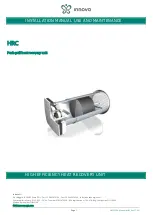
89
Speaker/Output Setup
—Continued
Bi-Amp for Front:
This setting can be made only when
you set the “(Speaker B) Front L/R” setting to “Main A”
or “Main B.” Select this when using the front speaker in
main room B by connecting the front channel and the
surround back channel to the speaker via Bi-Amp (See
page 28).
Not Used (default):
Select this when not using
surround back speakers.
Note:
If (Speaker A) Surr Back is set to “Main A 1ch,” you
cannot select “Main A 2ch” and “Main B 2ch” here.
(Speaker B) Subwoofer
This setting can be made only when you set the
“(Speaker B) Front L/R” setting to “Main A” or “Main
B.”
Main A:
Select this when using a subwoofer in main
room B.
Main B:
Select this when using a subwoofer in main
room B. This setting can only be made when you set the
“(Speaker B) Front L/R” setting to “Main B.”
Not Used (default):
Select this when not using a
subwoofer.
When the settings for Speaker Configuration are
completed, the subsequent settings should be speci-
fied separately in main room A, main room B, and
Zone 2.
Use this sub-menu to set the impedance level of the
TX-NR1000/TX-NR5000E to match the specifications
of the speakers you are using. The settings in the
Speaker Impedance sub-menu can be configured for
Main B and Zone 2 as well as for Main A.
The selectable parameters are common to all items.
Note:
Before you change this setting, be sure to first lower
the volume at the TX-NR1000/TX-NR5000E to the
minimum level.
8 ohms (default):
Select this when the impedance of
the connected speaker is 8 ohms or more.
6 ohms:
Select this when the impedance of the
connected speaker is no lower than 6 ohms and
no higher than 8 ohms.
4 ohms:
Select this when the impedance of the
connected speaker is no lower than 4 ohms and
no higher than 6 ohms.
• When “BTL for Front” is selected for “Surr Back”
from the Speaker Configuration sub-menu, the
corresponding “Front L/R” is automatically fixed to
“8 ohms,” and the impedance settings for the
surround back speakers are also removed. Please
verify that the impedance of a connected speaker is 8
ohms or more.
• For any speaker that is not available or set to “Not
Used” in the Speaker Configuration sub-menu, no
associated setting item is displayed.
The settings in the Speaker Crossover sub-menu can be
configured for both “Main A” and “Main B.”
Front L/R, Center, Surr L/R, Surr Back
Specify a threshold frequency in Hz for bass sounds
from each speaker to be output from the subwoofer.
When no subwoofer is used, (Speaker A) Front L/R is
automatically set to “Full Band,” and bass sounds from
each speaker are output from the front speakers. You
can also set other speakers to “Full Band.”
You can specify the frequency at 10 Hz increments
between 40-150 Hz. When using a THX-Select-certified
speaker system, specify the setting of
80 Hz (THX)
(default).
• If you specify the frequency of the front speakers
between 40-150 Hz, you cannot select “Full Band”
for the other speakers.
• For any speaker that is not available or set to “Not
Used” in the Speaker Configuration sub-menu, no
associated setting item is displayed.
• If “Surr Back” is set to “BTL for Front” or “Bi-Amp
for Front” on the Speaker Configuration sub-menu,
no item for surround back speakers is displayed.
LPF of LFE (setting of the low-pass filter for LFE)
Specify the low-pass filter for LFE (Low Frequency
Effect).
The low-pass filter passes through only the signal
components below the specified frequency, eliminating
the unwanted noise.
You can specify the frequency at 10 Hz increments
between 40-150 Hz.
SW Mode (Subwoofer Mode)
This item is displayed when a subwoofer is used (any
item other than “Not Used” is selected for Subwoofer
on the Speaker Configuration sub-menu), and Front L/R
is set to “Full Band” on the Speaker Crossover sub-
menu. Set the sound from the subwoofer to any of the
following:
LFE only:
The subwoofer outputs only LFE (Low
Frequency Effect) information.
D. Bass:
The subwoofer outputs not only LFE (Low
Frequency Effect) factors but also bass sounds from the
front speakers.
Measure the distance between the listening position and
each speaker. Specifying the distance will synchronize
the speakers in terms of the time that sounds from each
speaker reach the listening position. This is an
important specification for you to enjoy realistic home
theater. The settings in the Speaker Distance sub-menu
can be configured for both “Main A” and “Main B.”
Speaker Impedance Sub-menu
Speaker Crossover Sub-menu
Speaker Distance Sub-menu
















































